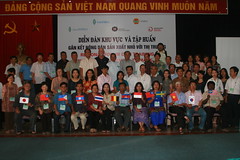Session 1 Presentation 1: The Market Situation and the Challenges for Small Farmers: Agri-business and Competitive Agro-Industries
Session 1: Current Context of the Market Situation in Asia
The Market Situation and the Challenges for Small Farmers: Agri-business and Competitive Agro-Industries
By Mr. David Hitchcock, Agribusiness and Infrastructure Officer, FAO Regional Office for Asia and the Pacific Mr. Hitchcock’s presentation focused on the macro-side or larger picture of agribusiness, which is an important aspect to understand about agriculture. There are real differences between small holders (small farmers) and the agri-businessmen and recent sector trends and impacts have made farmers very vulnerable. In general, the private sector continues to play an important role and more and more farmers are being disenfranchised. The market has also changed significantly since the 1970s such that while there are now more opportunities (e.g. bigger profits) for small farmers, there are also more risks. Other movements in agri-food systems include globalization, urbanization, changing diets, more women in the economy, etc.
Mr. Hitchcock’s presentation focused on the macro-side or larger picture of agribusiness, which is an important aspect to understand about agriculture. There are real differences between small holders (small farmers) and the agri-businessmen and recent sector trends and impacts have made farmers very vulnerable. In general, the private sector continues to play an important role and more and more farmers are being disenfranchised. The market has also changed significantly since the 1970s such that while there are now more opportunities (e.g. bigger profits) for small farmers, there are also more risks. Other movements in agri-food systems include globalization, urbanization, changing diets, more women in the economy, etc.
There are also organizational and institutional changes: before we just worried about our products, but now we need to worry about the quality, etc. The supply chain/value chain is changing and small farmers need to understand trends such as integrated and contract marketing because these are on the horizon and they will have an impact on them.
But agri-business and agro-industries are not “bad”. They can also create a big industry with a lot of opportunities. However, this can disadvantage people who cannot compete so it is necessary to educate, educate and educate. Agribusiness development is also context-specific: this highlights the need to get back to basics and learn from our mistakes/bad examples so that we can contextualize our experiences and adapt them to specific situations.
There is also a need to work with/through government to influence the policy environment. It is not enough that policies are in place; we need to look deeper into the policy guidelines and understand how things are actually implemented. A good policy environment will require bringing farmers together so that they can be given a voice; public private partnerships where there are equal agreements and incentives for farmers and the private sector to work together; safeguarding people’s rights; and revisiting the mandates of governments in providing information and services to farmers (governments are not very efficient at this so there is a need to harness other mechanisms)
On agro-industries and value chain programs, there is a need to look at business linkages, reduce transaction costs (in many cases, the small farmer can not compete with the transaction costs and it is the traders in between that gain the profit), and understand the supply or value chain. At the end of the day, what is important though is that farmers are not only organized, but are capacitated to do their jobs properly and more efficiently so they can produce high quality products. “You are the catalyst for small farmers. You can bring them together so they can compete. You can help build their skills and reduce their risks. You can also help them understand these risks so they can reduce these for themselves in the future.”
Download the The Market Situation and the Challenges for Small Farmers: Agri-business and Competitive Agro-Industries.ppt
